Polymer-II-VI Nanocrystals Blends: Basic Physics and Device Applications to Lasers and LEDs
Abstract
1. Introduction
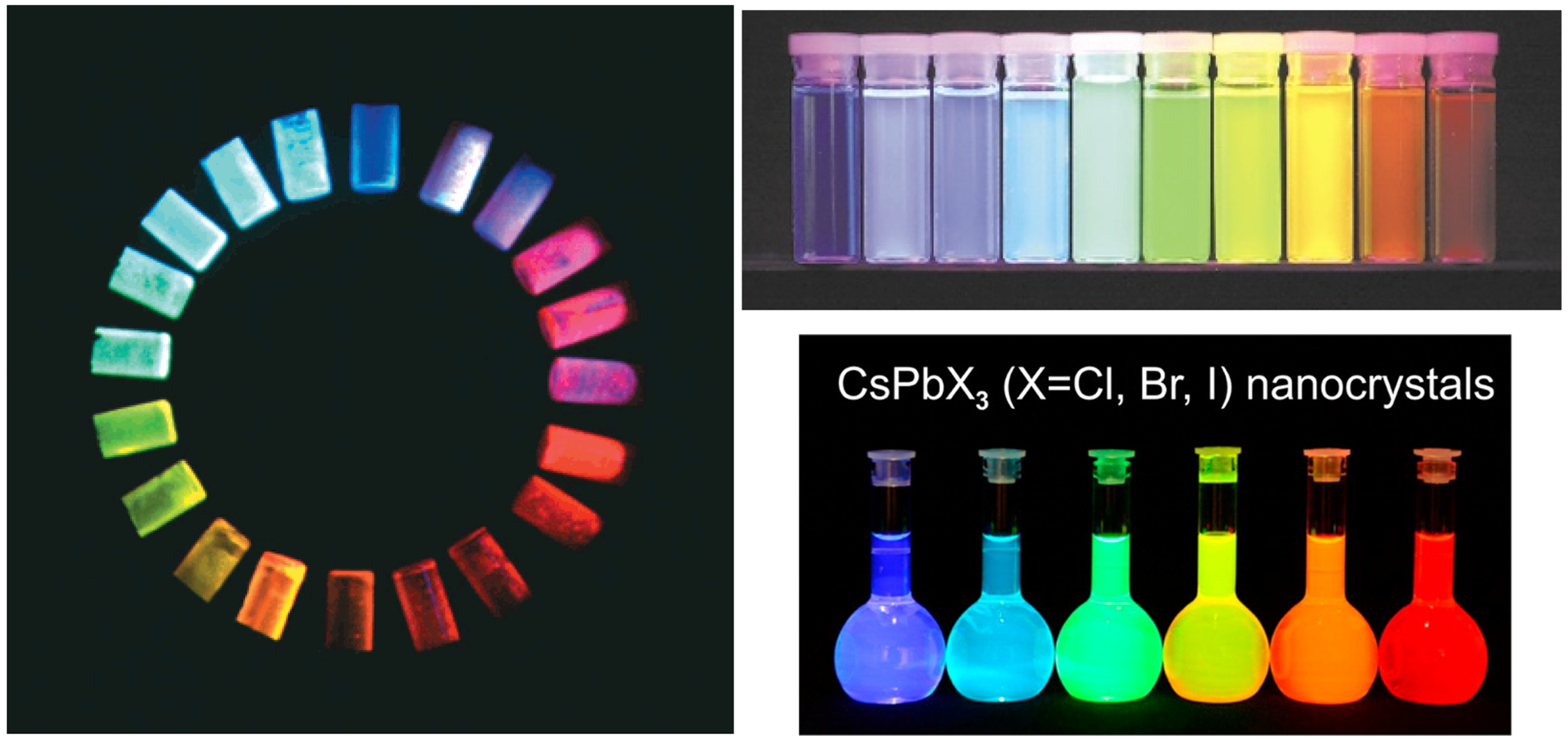
2. Physical Aspects of Polymer: NCs Photophysics
2.1. Basic Aspects of Polymer: NC Interaction
2.2. Basic Aspects of Light Amplification in NCs
3. Hybrid Polymer: NCs Devices
3.1. Lasers

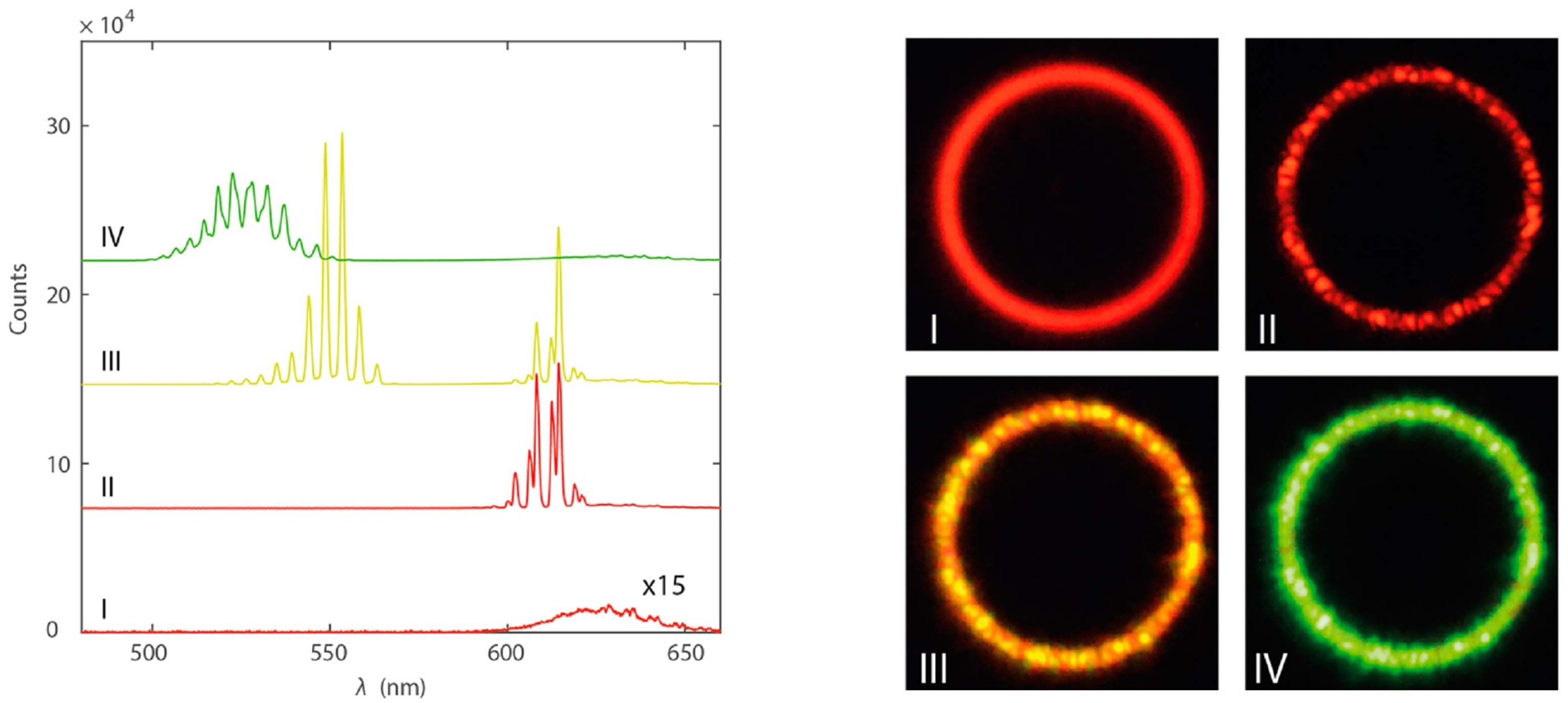
3.2. Light Emitting Diodes
4. Perspectives
Funding
Conflicts of Interest
References
- Barbarella, G.; Favaretto, L.; Sotgiu, G.; Zambianchi, M.; Bongini, A.; Arbizzani, C.; Mastragostino, M.; Anni, M.; Gigli, G.; Cingolani, R. Tuning Solid-State Photoluminescence Frequencies and Efficiencies of Oligomers Containing One Central Thiophene-S,S-dioxide Unit. J. Am. Chem. Soc. 2000, 122, 11971–11978. [Google Scholar] [CrossRef]
- Inigo, A.R.; Chang, C.; Fann, W.; White, J.D.; Huang, Y.S.; Jeng, U.S.; Sheu, H.S.; Peng, K.Y.; Chen, S.A. Enhanced Hole Mobility in Poly-(2-methoxy-5-(2’-ethylhexoxy)-1,4-phenylenevinylene) by Elimination of Nanometer-Sized Domains. Adv. Mater. 2005, 17, 1835–1838. [Google Scholar] [CrossRef]
- Shi, Y.; Liu, J.; Yang, Y. Device performance and polymer morphology in polymer light emitting diodes: The control of thin film morphology and device quantum efficiency. J. Appl. Phys. 2000, 87, 4254–4263. [Google Scholar] [CrossRef]
- Therezio, E.M.; Piovesan, E.; Anni, M.; Silva, R.A.; Oliveira, O.N.; Marletta, A. Substrate/semiconductor interface effects on the emission efficiency of luminescent polymers. J. Appl. Phys. 2011, 110, 044504. [Google Scholar] [CrossRef]
- Sirringhaus, H.; Kawase, T.; Friend, R.H.; Shimoda, T.; Inbasekaran, M.; Wu, W.; Woo, E.P. High-Resolution Inkjet Printing of All-Polymer Transistor Circuits. Science 2000, 290, 2123–2126. [Google Scholar] [CrossRef] [PubMed]
- Saf, R.; Goriup, M.; Steindl, T.; Hamedinger, T.E.; Sandholzer, D.; Hayn, G. Thin organic films by atmospheric-pressure ion deposition. Nat. Mater 2004, 3, 323–329. [Google Scholar] [CrossRef] [PubMed]
- Martino, M.; Caricato, A.P.; Romano, F.; Tunno, T.; Valerini, D.; Anni, M.; Caruso, M.E.; Romano, A.; Verri, T. Pulsed laser deposition of organic and biological materials. J. Mater. Sci. Mater. Electron. 2009, 20, 435–440. [Google Scholar] [CrossRef]
- Caricato, A.P.; Anni, M.; Cesaria, M.; Lattante, S.; Leggieri, G.; Leo, C.; Martino, M.; Perulli, A.; Resta, V. MAPLE-deposited PFO films: influence of the laser fluence and repetition rate on the film emission and morphology. Appl. Phys. B 2015, 119, 453–461. [Google Scholar] [CrossRef]
- Bhatnagar, P.K. Organic Light-Emitting Diodes—A Review. In Nanomaterials and Their Applications; Springer: Singapore, 2018; pp. 261–287. [Google Scholar] [CrossRef]
- Xue, R.; Zhang, J.; Li, Y.; Li, Y. Organic Solar Cell Materials toward Commercialization. Small 2018, 14, 1801793. [Google Scholar] [CrossRef]
- Lattante, S.; Perulli, A.; Anni, M. Study of the series resistance evolution in organic solar cells by use of the Lambert W function. Synth. Met. 2011, 161, 949–952. [Google Scholar] [CrossRef]
- Perulli, A.; Lattante, S.; Persano, A.; Cola, A.; Anni, M. On the homogeneity of the external quantum efficiency in a free OPV roll-to-roll flexible solar module. Synth. Met. 2019, 247, 248–254. [Google Scholar] [CrossRef]
- Anni, M.; Lattante, S. Organic Lasers: Fundamentals, Developments, and Applications; Pan Stanford Publishing: Singapore, 2018; pp. 1–324. [Google Scholar]
- Murray, C.B.; Norris, D.J.; Bawendi, M.G. Synthesis and characterization of nearly monodisperse CdE (E = sulfur, selenium, tellurium) semiconductor nanocrystallites. J. Am. Chem. Soc. 1993, 115, 8706–8715. [Google Scholar] [CrossRef]
- Hines, M.A.; Guyot-Sionnest, P. Synthesis and Characterization of Strongly Luminescing ZnS-Capped CdSe Nanocrystals. J. Phys. Chem. 1996, 100, 468–471. [Google Scholar] [CrossRef]
- Dabbousi, B.O.; Rodriguez-Viejo, J.; Mikulec, F.V.; Heine, J.R.; Mattoussi, H.; Ober, R.; Jensen, K.F.; Bawendi, M.G. (CdSe)ZnS Core-Shell Quantum Dots: Synthesis and Characterization of a Size Series of Highly Luminescent Nanocrystallites. J. Phys. Chem. B 1997, 101, 9463–9475. [Google Scholar] [CrossRef]
- Peng, X.; Schlamp, M.C.; Kadavanich, A.V.; Alivisatos, A.P. Epitaxial Growth of Highly Luminescent CdSe/CdS Core/Shell Nanocrystals with Photostability and Electronic Accessibility. J. Am. Chem. Soc. 1997, 119, 7019–7029. [Google Scholar] [CrossRef]
- Peng, X.; Manna, L.; Yang, W.; Wickham, J.; Scher, E.; Kadavanich, A.; Alivisatos, A.P. Shape control of CdSe nanocrystals. Nature 2000, 404, 59–61. [Google Scholar] [CrossRef] [PubMed]
- Manna, L.; Milliron, J.D.; Meisel, A.; Scher, E.C.; Alivisatos, A.P. Controlled growth of tetrapod branched inorganic nanocrystals. Nat. Mater. 2003, 2, 382–385. [Google Scholar] [CrossRef] [PubMed]
- Manna, L.; Scher, E.C.; Alivisatos, A.P. Synthesis of Soluble and Processable Rod-, Arrow-, Teardrop-, and Tetrapod-Shaped CdSe Nanocrystals. J. Am. Chem. Soc. 2000, 122, 12700–12706. [Google Scholar] [CrossRef]
- Carbone, L.; Nobile, C.; De Giorgi, M.; Sala, F.D.; Morello, G.; Pompa, P.; Hytch, M.; Snoeck, E.; Fiore, A.; Franchini, I.R.; et al. Synthesis and Micrometer-Scale Assembly of Colloidal CdSe/CdS Nanorods Prepared by a Seeded Growth Approach. Nano Lett. 2007, 7, 2942–2950. [Google Scholar] [CrossRef] [PubMed]
- Kovalenko, M.V.; Manna, L.; Cabot, A.; Hens, Z.; Talapin, D.V.; Kagan, C.R.; Klimov, V.I.; Rogach, A.L.; Reiss, P.; Milliron, D.J.; et al. Prospects of Nanoscience with Nanocrystals. ACS Nano 2015, 9, 1012–1057. [Google Scholar] [CrossRef]
- Wang, Y.; Sun, H. Advances and prospects of lasers developed from colloidal semiconductor nanostructures. Prog. Quantum Electron. 2018, 60, 1–29. [Google Scholar] [CrossRef]
- Bae, W.K.; Brovelli, S.; Klimov, V.I. Spectroscopic insights into the performance of quantum dot light emitting diodes. MRS Bull. 2013, 38, 721–730. [Google Scholar] [CrossRef]
- Dai, X.; Deng, Y.; Peng, X.; Jin, Y. Quantum-Dot Light-Emitting Diodes for Large-Area Displays: Towards the Dawn of Commercialization. Adv. Mater. 2017, 29, 1607022. [Google Scholar] [CrossRef] [PubMed]
- Shirasaki, Y.; Supran, G.J.; Bawendi, M.G.; Bulovic, V. Emergence of colloidal quantum dot light emitting technologies. Nat. Photonics 2013, 7, 13–23. [Google Scholar] [CrossRef]
- Pietryga, J.M.; Park, Y.S.; Lim, J.; Fidler, A.F.; Bae, W.K.; Brovelli, S.; Klimov, V.I. Spectroscopic and Device Aspects of Nanocrystal Quantum Dots. Chem. Rev. 2016, 116, 10513–10622. [Google Scholar] [CrossRef] [PubMed]
- Yang, Z.; Gao, M.; Wu, W.; Yang, X.; Sun, X.W.; Zhang, J.; Wang, H.C.; Liu, R.S.; Han, C.Y.; Yang, H.; et al. Recent advances in quantum dot-based light-emitting devices: Challenges and possible solutions. Mater. Today 2019, 24, 69–93. [Google Scholar] [CrossRef]
- Grim, J.Q.; Manna, L.; Moreels, I. A sustainable future for photonic colloidal nanocrystals. Chem. Soc. Rev. 2015, 44, 5897–5914. [Google Scholar] [CrossRef] [PubMed]
- Guzelturk, B.; Demir, H.V. Organic-Inorganic Composites of Semiconductor Nanocrystals for Efficient Excitonics. J. Phys. Chem. Lett. 2015, 6, 2206–2215. [Google Scholar] [CrossRef]
- Han, M.; Gao, X.; Su, J.Z.; Nie, S. Quantum-dot-tagged microbeads for multiplexed optical coding of biomolecules. Nat. Biotechnol. 2001, 19, 631–635. [Google Scholar] [CrossRef]
- Protesescu, L.; Yakunin, S.; Bodnarchuk, M.I.; Krieg, F.; Caputo, R.; Hendon, C.H.; Yang, R.X.; Walsh, A.; Kovalenko, M.V. Nanocrystals of Cesium Lead Halide Perovskites (CsPbX3, X = Cl, Br, and I): Novel Optoelectronic Materials Showing Bright Emission with Wide Color Gamut. Nano Lett. 2015, 15, 3692–3696. [Google Scholar] [CrossRef]
- Greenham, N.C.; Peng, X.; Alivisatos, A.P. Charge separation and transport in conjugated-polymer/semiconductor-nanocrystal composites studied by photoluminescence quenching and photoconductivity. Phys. Rev. B 1996, 54, 17628–17637. [Google Scholar] [CrossRef]
- Ginger, D.S.; Greenham, N.C. Photoinduced electron transfer from conjugated polymers to CdSe nanocrystals. Phys. Rev. B 1999, 59, 10622–10629. [Google Scholar] [CrossRef]
- Anni, M.; Manna, L.; Cingolani, R.; Valerini, D.; Cretí, A.; Lomascolo, M. Förster energy transfer from blue-emitting polymers to colloidal CdSe/ZnS core shell quantum dots. Appl. Phys. Lett. 2004, 85, 4169–4171. [Google Scholar] [CrossRef]
- Anni, M.; Manna, L.; Cingolani, R.; Valerini, D.; Cretí, A.; Lomascolo, M. Erratum: Förster energy transfer from blue-emitting polymers to colloidal CdSe/ZnS core shell quantum dots [Appl. Phys. Lett. 85, 4169 (2004)]. Appl. Phys. Lett. 2006, 88, 259901. [Google Scholar] [CrossRef]
- Kaufmann, S.; Stöferle, T.; Moll, N.; Mahrt, R.F.; Scherf, U.; Tsami, A.; Talapin, D.V.; Murray, C.B. Resonant energy transfer within a colloidal nanocrystal polymer host system. Appl. Phys. Lett. 2007, 90, 071108. [Google Scholar] [CrossRef]
- Stöferle, T.; Scherf, U.; Mahrt, R.F. Energy Transfer in Hybrid Organic/Inorganic Nanocomposites. Nano Lett. 2009, 9, 453–456. [Google Scholar] [CrossRef] [PubMed]
- Sharma, S.N.; Vats, T.; Dhenadhayalan, N.; Ramamurthy, P.; Narula, A. Ligand-dependent transient absorption studies of hybrid polymer:CdSe quantum dot composites. Sol. Energy Mater. Sol. Cells 2012, 100, 6–15. [Google Scholar] [CrossRef]
- Jing, P.; Yuan, X.; Ji, W.; Ikezawa, M.; Wang, Y.A.; Liu, X.; Zhang, L.; Zhao, J.; Masumoto, Y. Shell-Dependent Energy Transfer from 1,3,5-Tris(N-phenylbenzimidazol-2,yl) Benzene to CdSe Core/Shell Quantum Dots. J. Phys. Chem. C 2010, 114, 19256–19262. [Google Scholar] [CrossRef]
- Anni, M.; Alemanno, E.; Cretí, A.; Ingrosso, C.; Panniello, A.; Striccoli, M.; Curri, M.L.; Lomascolo, M. Interplay between Amplified Spontaneous Emission, Förster Resonant Energy Transfer, and Self-Absorption in Hybrid Poly(9,9-dioctylfluorene)-CdSe/ZnS Nanocrystal Thin Films. J. Phys. Chem. A 2010, 114, 2086–2090. [Google Scholar] [CrossRef]
- Klimov, V.I.; Mikhailovsky, A.A.; McBranch, D.W.; Leatherdale, C.A.; Bawendi, M.G. Quantization of Multiparticle Auger Rates in Semiconductor Quantum Dots. Science 2000, 287, 1011–1013. [Google Scholar] [CrossRef]
- Lattante, S.; Cretí, A.; Lomascolo, M.; Anni, M. On the correlation between morphology and Amplified Spontaneous Emission properties of a polymer:polymer blend. Org. Electron. 2016, 29, 44–49. [Google Scholar] [CrossRef]
- Anikeeva, P.; Madigan, C.; Coe-Sullivan, S.; Steckel, J.; Bawendi, M.; Bulovic, V. Photoluminescence of CdSe/ZnS core/shell quantum dots enhanced by energy transfer from a phosphorescent donor. Chem. Phys. Lett. 2006, 424, 120–125. [Google Scholar] [CrossRef]
- Lutich, A.A.; Pöschl, A.; Jiang, G.; Stefani, F.D.; Susha, A.S.; Rogach, A.L.; Feldmann, J. Efficient energy transfer in layered hybrid organic/inorganic nanocomposites: A dual function of semiconductor nanocrystals. Appl. Phys. Lett. 2010, 96, 083109. [Google Scholar] [CrossRef]
- Kowerko, D.; Schuster, J.; Amecke, N.; Abdel-Mottaleb, M.; Dobrawa, R.; Würthner, F.; von Borczyskowski, C. FRET and ligand related NON-FRET processes in single quantum dot-perylene bisimide assemblies. Phys. Chem. Chem. Phys. 2010, 12, 4112–4123. [Google Scholar] [CrossRef]
- Curutchet, C.; Franceschetti, A.; Zunger, A.; Scholes, G.D. Examining Förster Energy Transfer for Semiconductor Nanocrystalline Quantum Dot Donors and Acceptors. J. Phys. Chem. C 2008, 112, 13336–13341. [Google Scholar] [CrossRef]
- Lutich, A.A.; Jiang, G.; Susha, A.S.; Rogach, A.L.; Stefani, F.D.; Feldmann, J. Energy Transfer versus Charge Separation in Type-II Hybrid Organic-Inorganic Nanocomposites. Nano Lett. 2009, 9, 2636–2640. [Google Scholar] [CrossRef]
- Sih, B.C.; Wolf, M.O. CdSe Nanorods Functionalized with Thiol-Anchored Oligothiophenes. J. Phys. Chem. C 2007, 111, 17184–17192. [Google Scholar] [CrossRef]
- Odoi, M.Y.; Hammer, N.I.; Sill, K.; Emrick, T.; Barnes, M.D. Observation of Enhanced Energy Transfer in Individual Quantum Dot-Oligophenylene Vinylene Nanostructures. J. Am. Chem. Soc. 2006, 128, 3506–3507. [Google Scholar] [CrossRef]
- Holzinger, M.; Le Goff, A.; Cosnier, S. Nanomaterials for biosensing applications: A review. Front. Chem. 2014, 2, 63. [Google Scholar] [CrossRef]
- Moroz, P.; Royo Romero, L.; Zamkov, M. Colloidal semiconductor nanocrystals in energy transfer reactions. Chem. Commun. 2019, 55, 3033–3048. [Google Scholar] [CrossRef]
- Hildebrandt, N.; Spillmann, C.M.; Algar, W.R.; Pons, T.; Stewart, M.H.; Oh, E.; Susumu, K.; Diaz, S.A.; Delehanty, J.B.; Medintz, I.L. Energy Transfer with Semiconductor Quantum Dot Bioconjugates: A Versatile Platform for Biosensing, Energy Harvesting, and Other Developing Applications. Chem. Rev. 2017, 117, 536–711. [Google Scholar] [CrossRef]
- Algar, W.R.; Khachatrian, A.; Melinger, J.S.; Huston, A.L.; Stewart, M.H.; Susumu, K.; Blanco-Canosa, J.B.; Oh, E.; Dawson, P.E.; Medintz, I.L. Concurrent Modulation of Quantum Dot Photoluminescence Using a Combination of Charge Transfer and Förster Resonance Energy Transfer: Competitive Quenching and Multiplexed Biosensing Modality. J. Am. Chem. Soc. 2017, 139, 363–372. [Google Scholar] [CrossRef]
- Claussen, J.C.; Hildebrandt, N.; Susumu, K.; Ancona, M.G.; Medintz, I.L. Complex Logic Functions Implemented with Quantum Dot Bionanophotonic Circuits. ACS Appl. Mater. Interfaces 2014, 6, 3771–3778. [Google Scholar] [CrossRef]
- Alam, R.; Zylstra, J.; Fontaine, D.M.; Branchini, B.R.; Maye, M.M. Novel multistep BRET-FRET energy transfer using nanoconjugates of firefly proteins, quantum dots, and red fluorescent proteins. Nanoscale 2013, 5, 5303–5306. [Google Scholar] [CrossRef]
- Dwyer, C.L.; Diaz, S.A.; Walper, S.A.; Samanta, A.; Susumu, K.; Oh, E.; Buckhout-White, S.; Medintz, I.L. Chemoenzymatic Sensitization of DNA Photonic Wires Mediated through Quantum Dot Energy Transfer Relays. Chem. Mater. 2015, 27, 6490–6494. [Google Scholar] [CrossRef]
- Algar, W.R.; Ancona, M.G.; Malanoski, A.P.; Susumu, K.; Medintz, I.L. Assembly of a Concentric Förster Resonance Energy Transfer Relay on a Quantum Dot Scaffold: Characterization and Application to Multiplexed Protease Sensing. ACS Nano 2012, 6, 11044–11058. [Google Scholar] [CrossRef]
- Klimov, V.I.; Mikhailovsky, A.A.; Xu, S.; Malko, A.; Hollingsworth, J.A.; Leatherdale, C.A.; Eisler, H.J.; Bawendi, M.G. Optical Gain and Stimulated Emission in Nanocrystal Quantum Dots. Science 2000, 290, 314–317. [Google Scholar] [CrossRef]
- Htoon, H.; Hollingsworth, J.A.; Dickerson, R.; Klimov, V.I. Effect of Zero- to One-Dimensional Transformation on Multiparticle Auger Recombination in Semiconductor Quantum Rods. Phys. Rev. Lett. 2003, 91, 227401. [Google Scholar] [CrossRef]
- Kim, S.; Fisher, B.; Eisler, H.J.; Bawendi, M. Type-II Quantum Dots: CdTe/CdSe(Core/Shell) and CdSe/ZnTe(Core/Shell) Heterostructures. J. Am. Chem. Soc. 2003, 125, 11466–11467. [Google Scholar] [CrossRef]
- Bae, W.K.; Padilha, L.A.; Park, Y.S.; McDaniel, H.; Robel, I.; Pietryga, J.M.; Klimov, V.I. Controlled Alloying of the Core Shell Interface in CdSe/CdS Quantum Dots for Suppression of Auger Recombination. ACS Nano 2013, 7, 3411–3419. [Google Scholar] [CrossRef]
- Wang, Y.; Fong, K.E.; Yang, S.; Ta, V.; Gao, Y.; Wang, Z.; Nalla, V.; Demir, H.V.; Sun, H. Unraveling the ultralow threshold stimulated emission from CdZnS/ZnS quantum dot and enabling high-Q microlasers. Laser Photonics Rev. 2015, 9, 507–516. [Google Scholar] [CrossRef]
- Yang, Z.; Pelton, M.; Fedin, I.; Talapin, D.V.; Waks, E. A room temperature continuous-wave nanolaser using colloidal quantum wells. Nat. Commun. 2017, 8, 143. [Google Scholar] [CrossRef]
- Grim, J.Q.; Christodoulou, S.; Di Stasio, F.; Krahne, R.; Cingolani, R.; Manna, L.; Moreels, I. Continuous-wave biexciton lasing at room temperature using solution-processed quantum wells. Nat. Nanotechnol. 2014, 9, 891–895. [Google Scholar] [CrossRef]
- Jones, M.; Nedeljkovic, J.; Ellingson, R.J.; Nozik, A.J.; Rumbles, G. Photoenhancement of Luminescence in Colloidal CdSe Quantum Dot Solutions. J. Phys. Chem. B 2003, 107, 11346–11352. [Google Scholar] [CrossRef]
- Snee, P.T.; Chan, Y.; Nocera, D.G.; Bawendi, M.G. Whispering-Gallery-Mode Lasing from a Semiconductor Nanocrystal/Microsphere Resonator Composite. Adv. Mater. 2005, 17, 1131–1136. [Google Scholar] [CrossRef]
- Chan, Y.; Snee, P.T.; Caruge, J.M.; Yen, B.K.; Nair, G.P.; Nocera, D.G.; Bawendi, M.G. A Solvent-Stable Nanocrystal-Silica Composite Laser. J. Am. Chem. Soc. 2006, 128, 3146–3147. [Google Scholar] [CrossRef]
- Zavelani-Rossi, M.; Lupo, M.G.; Krahne, R.; Manna, L.; Lanzani, G. Lasing in self-assembled microcavities of CdSe/CdS core/shell colloidal quantum rods. Nanoscale 2010, 2, 931–935. [Google Scholar] [CrossRef]
- Zavelani-Rossi, M.; Krahne, R.; Della Valle, G.; Longhi, S.; Franchini, I.; Girardo, S.; Scotognella, F.; Pisignano, D.; Manna, L.; Lanzani, G.; et al. Self-assembled CdSe/CdS nanorod micro-lasers fabricated from solution by capillary jet deposition. Laser Photonics Rev. 2012, 6, 678–683. [Google Scholar] [CrossRef]
- Di Stasio, F.; Grim, J.Q.; Lesnyak, V.; Rastogi, P.; Manna, L.; Moreels, I.; Krahne, R. Single-Mode Lasing from Colloidal Water-Soluble CdSe/CdS Quantum Dot-in-Rods. Small 2015, 11, 1328–1334. [Google Scholar] [CrossRef]
- Liao, C.; Xu, R.; Xu, Y.; Zhang, C.; Xiao, M.; Zhang, L.; Lu, C.; Cui, Y.; Zhang, J. Ultralow-Threshold Single-Mode Lasing from Phase-Pure CdSe/CdS Core/Shell Quantum Dots. J. Phys. Chem. Lett. 2016, 7, 4968–4976. [Google Scholar] [CrossRef]
- Le Feber, B.; Prins, F.; De Leo, E.; Rabouw, F.T.; Norris, D.J. Colloidal-Quantum-Dot Ring Lasers with Active Color Control. Nano Lett. 2018, 18, 1028–1034. [Google Scholar] [CrossRef]
- Wang, Y.; Ta, V.D.; Leck, K.S.; Tan, B.H.I.; Wang, Z.; He, T.; Ohl, C.D.; Demir, H.V.; Sun, H. Robust Whispering-Gallery-Mode Microbubble Lasers from Colloidal Quantum Dots. Nano Lett. 2017, 17, 2640–2646. [Google Scholar] [CrossRef]
- Yang, X.; Li, B. Laser Emission from Ring Resonators Formed by a Quantum-Dot-Doped Single Polymer Nanowire. ACS Macro Lett. 2014, 3, 1266–1270. [Google Scholar] [CrossRef]
- Anni, M. A flexible organic random laser based on poly(9,9-dioctylfluorene) deposited on a surface corrugated poly-phthalate-carbonate substrate. Appl. Phys. Lett. 2011, 98, 253304. [Google Scholar] [CrossRef]
- Anni, M.; Rhee, D.; Lee, W.K. Random Lasing Engineering in Poly-(9-9dioctylfluorene) Active Waveguides Deposited on Wrinkles Corrugated Surfaces. ACS Appl. Mater. Interfaces 2019, 11, 9385–9393. [Google Scholar] [CrossRef]
- Chen, Y.; Herrnsdorf, J.; Guilhabert, B.; Zhang, Y.; Watson, I.M.; Gu, E.; Laurand, N.; Dawson, M.D. Colloidal quantum dot random laser. Opt. Express 2011, 19, 2996–3003. [Google Scholar] [CrossRef]
- Gollner, C.; Ziegler, J.; Protesescu, L.; Dirin, D.N.; Lechner, R.T.; Fritz-Popovski, G.; Sytnyk, M.; Yakunin, S.; Rotter, S.; Yousefi Amin, A.A.; et al. Random Lasing with Systematic Threshold Behavior in Films of CdSe/CdS Core/Thick-Shell Colloidal Quantum Dots. ACS Nano 2015, 9, 9792–9801. [Google Scholar] [CrossRef]
- Di Stasio, F.; Polovitsyn, A.; Angeloni, I.; Moreels, I.; Krahne, R. Broadband Amplified Spontaneous Emission and Random Lasing from Wurtzite CdSe/CsS Giant-Shell Nanocrystals. ACS Photonics 2016, 3, 2083–2088. [Google Scholar] [CrossRef]
- Cao, M.; Zhang, Y.; Song, X.; Che, Y.; Zhang, H.; Dai, H.; Zhang, G.; Yao, J. Random lasing in a colloidal quantum dot-doped disordered polymer. Opt. Express 2016, 24, 9325–9331. [Google Scholar] [CrossRef]
- Eisler, H.J.; Sundar, V.C.; Bawendi, M.G.; Walsh, M.; Smith, H.I.; Klimov, V. Color-selective semiconductor nanocrystal laser. Appl. Phys. Lett. 2002, 80, 4614–4616. [Google Scholar] [CrossRef]
- Sundar, V.C.; Eisler, H.J.; Deng, T.; Chan, Y.; Thomas, E.L.; Bawendi, M.G. Soft-Lithographically Embossed, Multilayered Distributed-Feedback Nanocrystal Lasers. Adv. Mater. 2004, 16, 2137–2141. [Google Scholar] [CrossRef]
- Guilhabert, B.; Foucher, C.; Haughey, A.M.; Mutlugun, E.; Gao, Y.; Herrnsdorf, J.; Sun, H.; Demir, H.; Dawson, M.; Laurand, N. Nanosecond colloidal quantum dot lasers for sensing. Opt. Express 2014, 22, 7308–7319. [Google Scholar] [CrossRef]
- Roh, K.; Dang, C.; Lee, J.; Chen, S.; Steckel, J.S.; Coe-Sullivan, S.; Nurmikko, A. Surface-emitting red, green, and blue colloidal quantum dot distributed feedback lasers. Opt. Express 2014, 22, 18800–18806. [Google Scholar] [CrossRef]
- McLellan, L.J.; Guilhabert, B.; Laurand, N.; Dawson, M.D. CdSxSe1-x/ZnS semiconductor nanocrystal laser with sub 10kW/cm2 threshold and 40nJ emission output at 600 nm. Opt. Express 2016, 24, A146–A153. [Google Scholar] [CrossRef]
- Dang, C.; Lee, J.; Breen, C.; Steckel, J.S.; Coe-Sullivan, S.; Nurmikko, A. Red, green and blue lasing enabled bysingle-exciton gain in colloidal quantum dot films. Nat. Nanotechnol. 2012, 7, 335–339. [Google Scholar] [CrossRef]
- Kim, H.; Cho, K.S.; Jeong, H.; Kim, J.; Lee, C.W.; Koh, W.k.; Roh, Y.G.; Hwang, S.W.; Park, Y. Single-Mode Lasing from a Monolithic Microcavity with Few-Monolayer-Thick Quantum Dot Films. ACS Photonics 2016, 3, 1536–1541. [Google Scholar] [CrossRef]
- Manfredi, G.; Lova, P.; Di Stasio, F.; Rastogi, P.; Krahne, R.; Comoretto, D. Lasing from dot-in-rod nanocrystals in planar polymer microcavities. RSC Adv. 2018, 8, 13026–13033. [Google Scholar] [CrossRef]
- Colvin, V.L.; Schlamp, M.C.; Alivisatos, A.P. Light-emitting diodes made from cadmium selenide nanocrystals and a semiconducting polymer. Nature 1994, 370, 354–357. [Google Scholar] [CrossRef]
- Dabbousi, B.O.; Bawendi, M.G.; Onitsuka, O.; Rubner, M.F. Electroluminescence from CdSe quantum dot/polymer composites. Appl. Phys. Lett. 1995, 66, 1316–1318. [Google Scholar] [CrossRef]
- Chin, P.T.K.; Hikmet, R.A.M.; Janssen, R.A.J. Energy transfer in hybrid quantum dot light emitting diodes. J. Appl. Phys. 2008, 104, 013108. [Google Scholar] [CrossRef]
- Guzelturk, B.; Hernandez-Martinez, P.L.; Sharma, V.K.; Coskun, Y.; Ibrahimova, V.; Tuncel, D.; Govorov, A.O.; Sun, X.W.; Xiong, Q.; Demir, H.V. Study of exciton transfer in dense quantum dot nanocomposites. Nanoscale 2014, 6, 11387–11394. [Google Scholar] [CrossRef]
- Borg, L.z.; Lee, D.; Lim, J.; Bae, W.K.; Park, M.; Lee, S.; Lee, C.; Char, K.; Zentel, R. The effect of band gap alignment on the hole transport from semiconducting block copolymers to quantum dots. J. Mater. Chem. C 2013, 1, 1722–1726. [Google Scholar] [CrossRef]
- Park, J.H.; Kim, J.Y.; Chin, B.D.; Kim, Y.C.; Kim, J.K.; Park, O.O. White emission from polymer/quantum dot ternary nanocomposites by incomplete energy transfer. Nanotechnology 2004, 15, 1217–1220. [Google Scholar] [CrossRef]
- Xuan, Y.; Pan, D.; Zhao, N.; Ji, X.; Ma, D. White electroluminescence from a poly(N-vinylcarbazole) layer doped with CdSe/CdS core–shell quantum dots. Nanotechnology 2006, 17, 4966–4969. [Google Scholar] [CrossRef]
- Li, Y.; Rizzo, A.; Mazzeo, M.; Carbone, L.; Manna, L.; Cingolani, R.; Gigli, G. White organic light-emitting devices with CdSe/ZnS quantum dots as a red emitter. J. Appl. Phys. 2005, 97, 113501. [Google Scholar] [CrossRef]
- Ahn, J.H.; Bertoni, C.; Dunn, S.; Wang, C.; Talapin, D.V.; Gaponik, N.; Eychmüller, A.; Hua, Y.; Bryce, M.R.; Petty, M.C. White organic light-emitting devices incorporating nanoparticles of II-VI semiconductors. Nanotechnology 2007, 18, 335202. [Google Scholar] [CrossRef]
- Lee, J.S.; Kang, B.H.; Kim, S.H.; Lee, J.W.; Lee, S.W.; Kim, S.W.; Gopalan, S.A.; Kwon, J.B.; Bae, J.H.; Kim, E.S.; et al. All-solution-processed high-brightness hybrid white quantum-dot light-emitting devices utilizing polymer modified quantum dots. Org. Electron. 2017, 42, 393–398. [Google Scholar] [CrossRef]
- Wang, Y.; Morawska, P.O.; Kanibolotsky, A.L.; Skabara, P.J.; Turnbull, G.A.; Samuel, I.D.W. LED pumped polymer laser sensor for explosives. Laser Photonics Rev. 2013, 7, L71–L76. [Google Scholar] [CrossRef]
- Yakunin, S.; Protesescu, L.; Krieg, F.; Bodnarchuk, M.I.; Nedelcu, G.; Humer, M.; De Luca, G.; Fiebig, M.; Heiss, W.; Kovalenko, M.V. Low-Threshold Amplified Spontaneous Emission and Lasing From Colloidal Nanocrystals of Caesium Lead Halide Perovskites. Nat. Commun. 2015, 6, 8056. [Google Scholar] [CrossRef]
- Harwell, J.R.; Whitworth, G.L.; Turnbull, G.A.; Samuel, I.D.W. Green Perovskite Distributed Feedback Lasers. Sci. Rep. 2017, 7, 11727. [Google Scholar] [CrossRef]
- De Giorgi, M.L.; Perulli, A.; Yantara, N.; Boix, P.P.; Anni, M. Amplified Spontaneous Emission Properties of Solution Processed CsPbBr3 Perovskite Thin Films. J. Phys. Chem. C 2017, 121, 14772–14778. [Google Scholar] [CrossRef]
- Balena, A.; Perulli, A.; Fernandez, M.; De Giorgi, M.L.; Nedelcu, G.; Kovalenko, M.V.; Anni, M. Temperature Dependence of the Amplified Spontaneous Emission from CsPbBr3 Nanocrystal Thin Films. J. Phys. Chem. C 2018, 122, 5813–5819. [Google Scholar] [CrossRef]
- Evans, T.J.S.; Schlaus, A.; Fu, Y.; Zhong, X.; Atallah, T.L.; Spencer, M.S.; Brus, L.E.; Jin, S.; Zhu, X.Y. Continuous-Wave Lasing in Cesium Lead Bromide Perovskite Nanowires. Adv. Opt. Mater. 2018, 6, 1700982. [Google Scholar] [CrossRef]
- Zhang, Q.; Tavakoli, M.M.; Gu, L.; Zhang, D.; Tang, L.; Gao, Y.; Guo, J.; Lin, Y.; Leung, S.F.; Poddar, S.; et al. Efficient metal halide perovskite light-emitting diodes with significantly improved light extraction on nanophotonic substrates. Nat. Commun. 2019, 10, 727. [Google Scholar] [CrossRef]
- Tan, Z.K.; Moghaddam, R.S.; Lai, M.L.; Docampo, P.; Higler, R.; Deschler, F.; Price, M.; Sadhanala, A.; Pazos, L.M.; Credgington, D.; et al. Bright light emitting diodes based on organometal halide perovskite. Nat. Nanotechnol. 2014, 9, 687–692. [Google Scholar] [CrossRef]
- Perulli, A.; Balena, A.; Fernandez, M.; Nedelcu, G.; Cretí, A.; Kovalenko, M.V.; Lomascolo, M.; Anni, M. Full-color tuning in binary polymer:perovskite nanocrystals organic-inorganic hybrid blends. Appl. Phys. Lett. 2018, 112, 171904. [Google Scholar] [CrossRef]
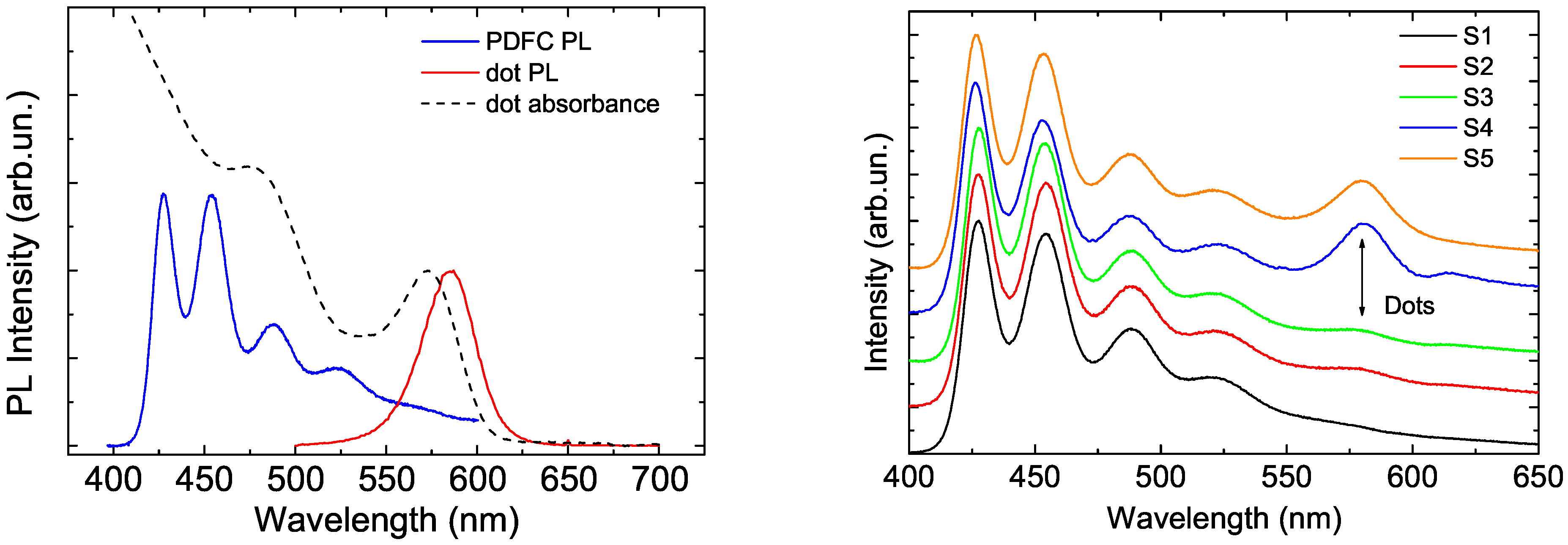
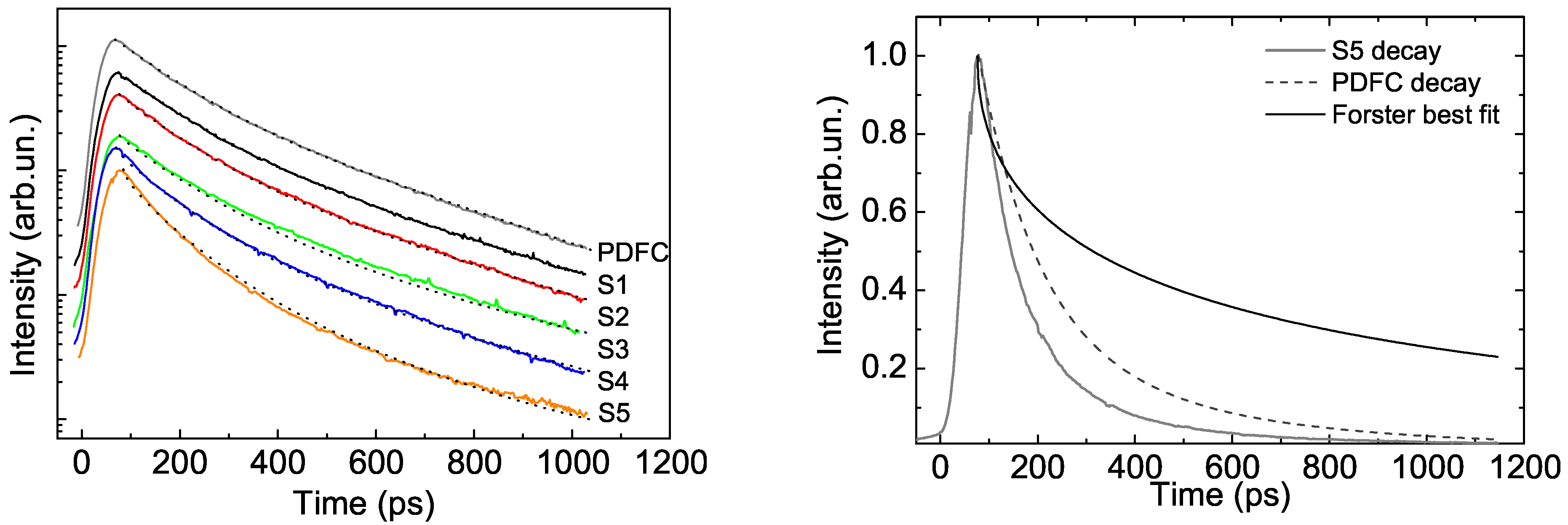
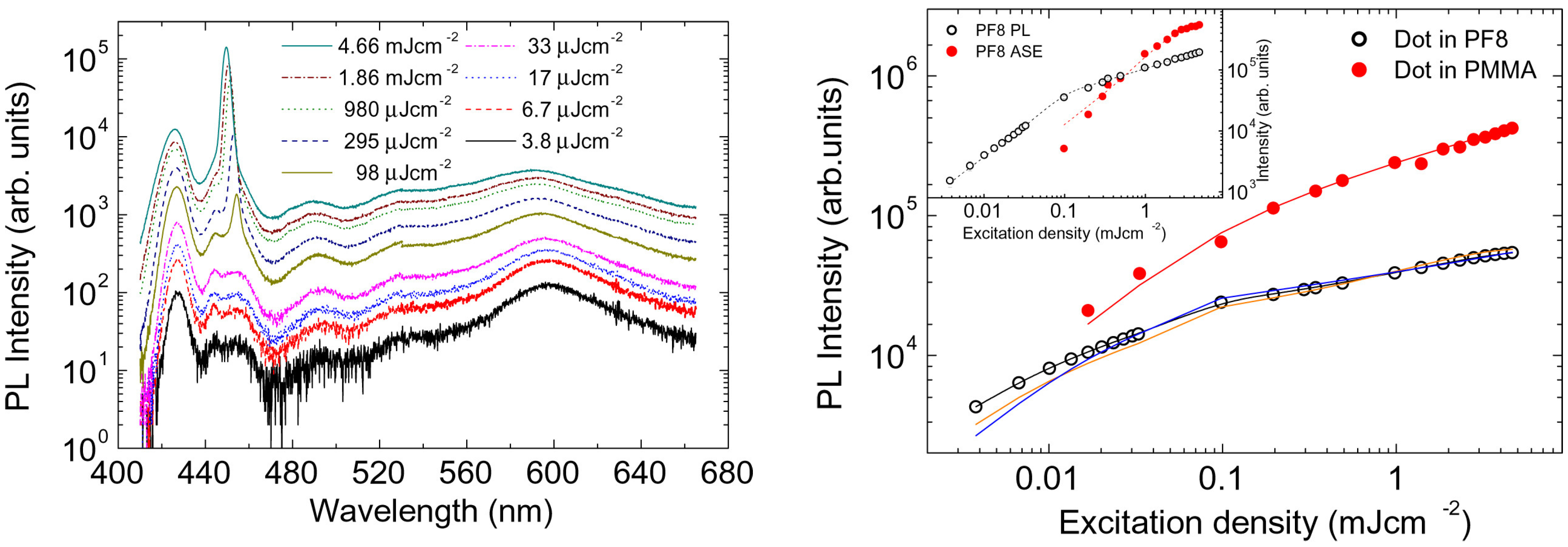


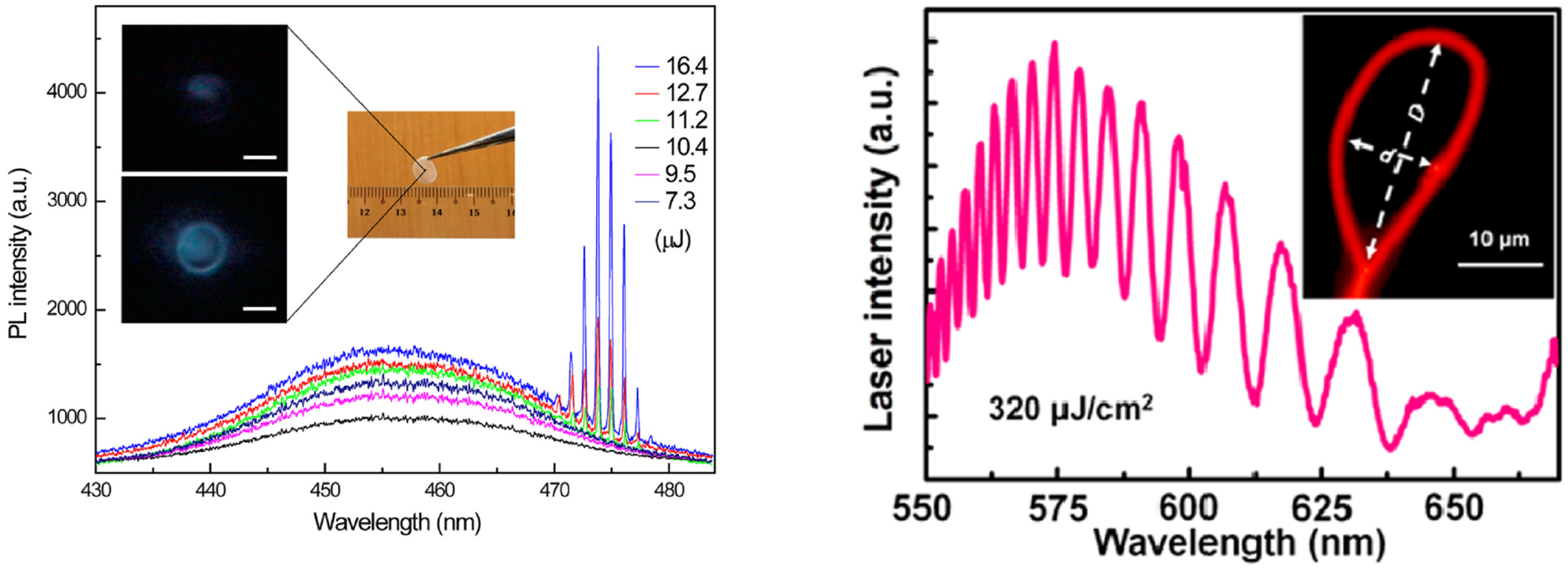
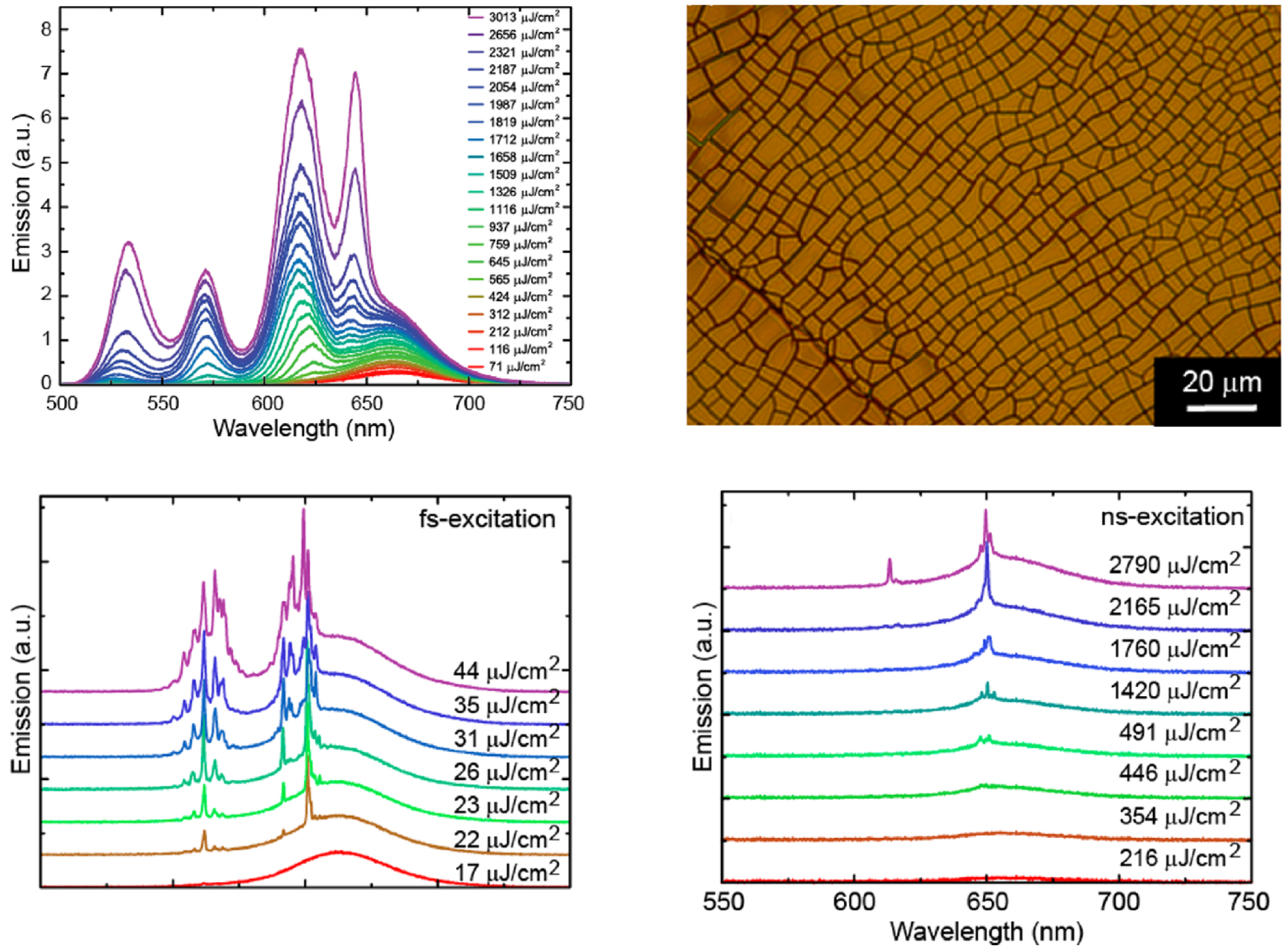
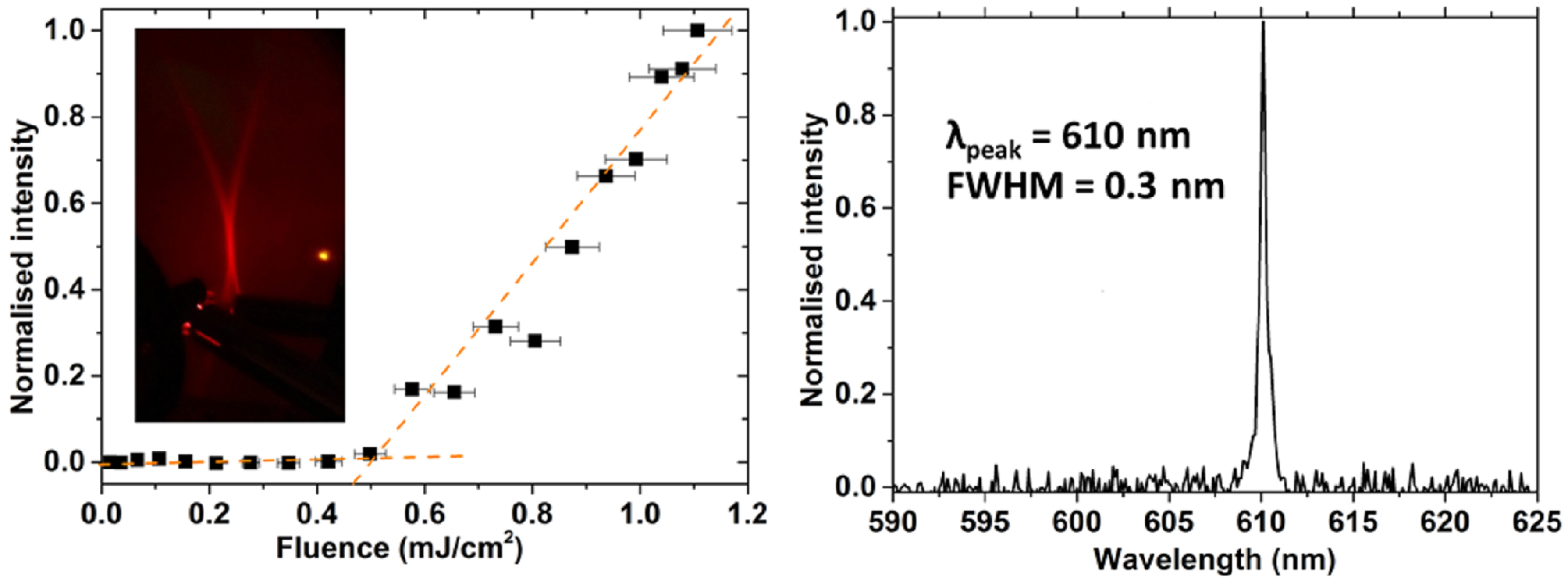
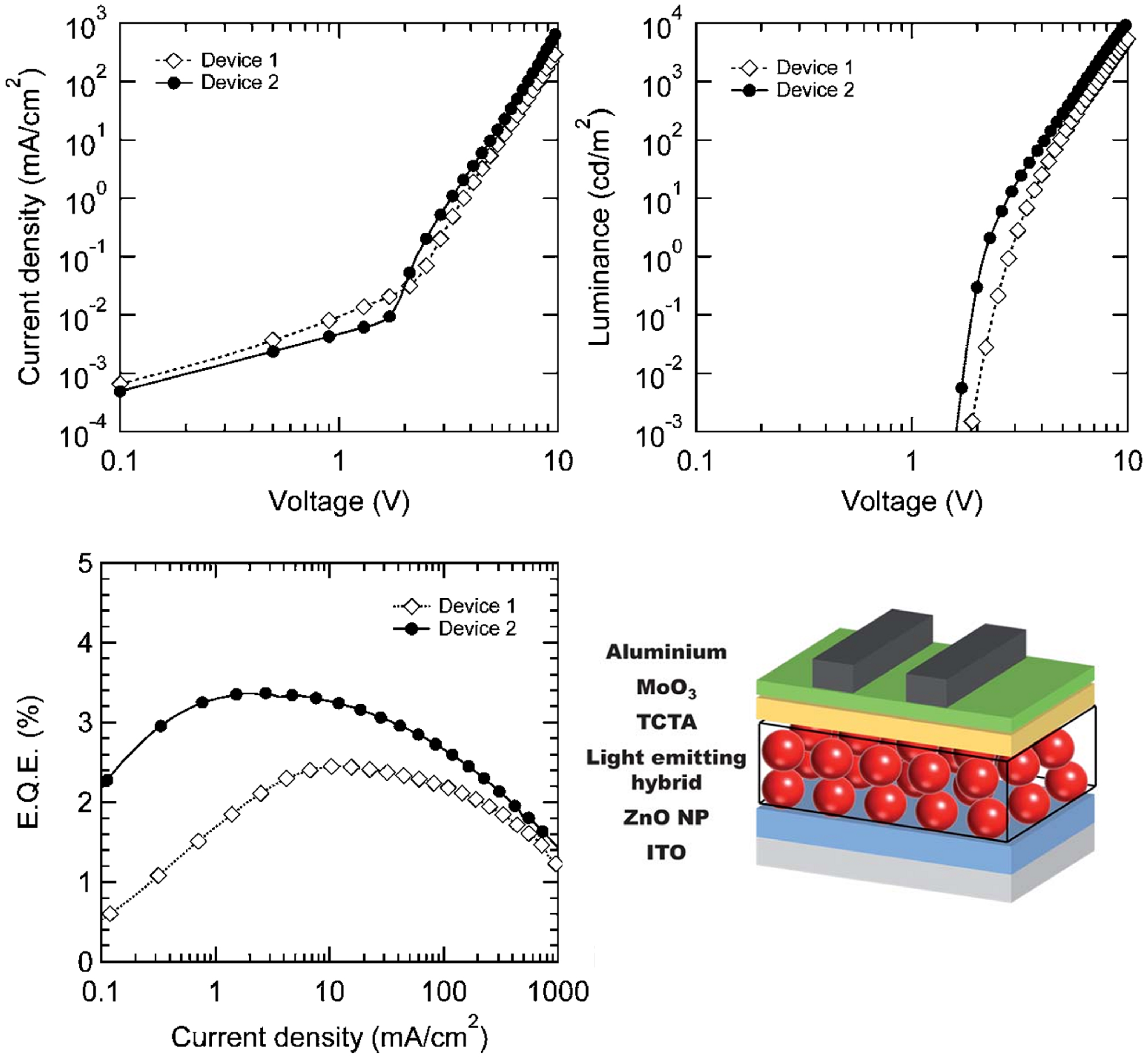
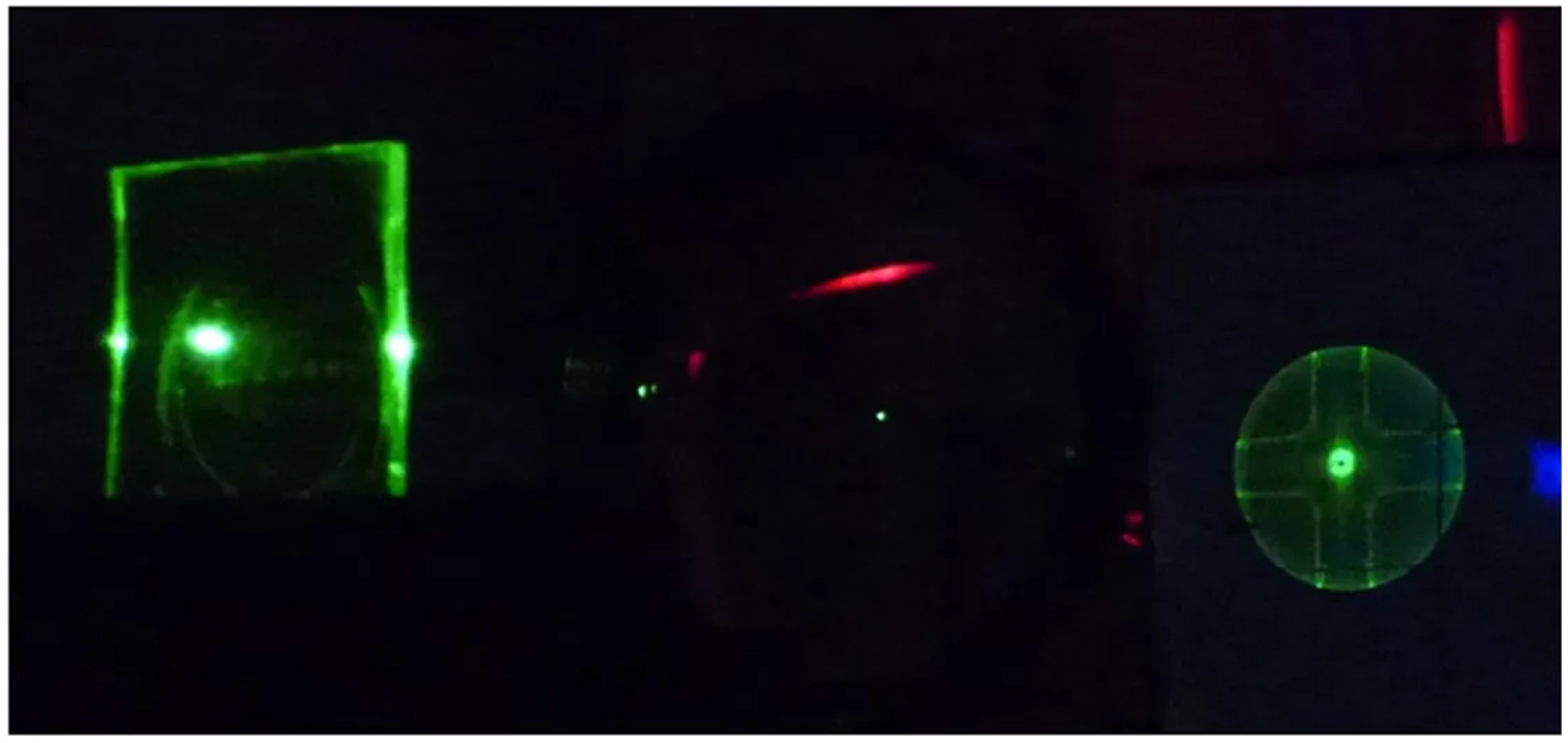
| Active Material | Cavity Geometry | Pump Pulse Length | Threshold | Peak Wavelength (nm) | Ref. |
|---|---|---|---|---|---|
| CdSe/CdS g-NCs | ASE | 70 fs | 45–105 J cm | 612, 648 (dual band) | [80] |
| CdSe/CdS DiR | ASE | 70 fs | 115 J cm | 628 | [71] |
| CdSe/ZnCdS pyramids | ASE | 100 fs | 800 J cm | 450 | [87] |
| CdSe/ZnCdS pyramids | ASE | 100 fs | 145 J cm | 565 | [87] |
| CdSe/ZnCdS pyramids | ASE | 100 fs | 90 J cm | 625 | [87] |
| CdZnS QDs | ASE | 100 fs | 260 J cm | 472 | [63] |
| CdZnS/ZnS QDs SS | ASE | 100 fs | 160 J cm | 468 | [63] |
| CdZnS/ZnS QDs AS | ASE | 100 fs | 55 J cm | 463 | [63] |
| CdSe/ZnS QDs-PMMA | ASE | 5 ns | 1.0 mJ cm | 611 | [84] |
| CdSSe/ZnS | ASE | 5 ns | 800 J cm | 600 | [86] |
| CdSSe/ZnS-PVA | ASE | 5 ns | 380 J cm | 600 | [86] |
| CdSe/CdZnS QDs-titania | microsphere | 100 fs | 8.1 mJ cm | ∼660 nm | [68] |
| CdSe/CdS DiR | microring | 70 fs | 15 J cm | 632 | [71] |
| CdSe/CdS DiR | microring | 100 fs | 200 J cm | 495.5 | [70] |
| CdSe/CdS QDs | microring | 100 fs | 2 J cm | 636 | [72] |
| CdSe/CdS QRs | microring | 150 fs | 3.0 mJ cm | ∼660 nm | [69] |
| CdSe/CdS/ZnS QDs | microring | 340 fs | 22 J cm | 610 | [73] |
| CdSe/CdS/ZnS QDs | microring | 340 fs | 110 J cm | 530 | [73] |
| CdSe/ZnS QDs-PVP | microring | 300 ps | 110 J cm | 600 | [75] |
| CdSe/CdS g-NCs | random | 70 fs | 22 J cm | 610, 650 (dual band) | [80] |
| CdSe/CdS QDs | random | 1.3 ns | 2.5 mJ cm | 610 nm | [79] |
| CdSe/CdS g-NCs | random | 3ns | 490 J cm | 610, 650 (dual band) | [80] |
| CdSe/ZnS QDs | random | 5 ns | 25 mJ cm | 600 nm | [78] |
| CdSe/ZnS QDS-NOA65-resin | random | 8 ns | 7 mJ cm | 615 nm | [81] |
| CdSe/ZnCdS CQDs | DFB | 400 ps | 330 J cm | 455 nm | [85] |
| CdSe/ZnCdS CQDs | DFB | 400 ps | 280 J cm | 575 nm | [85] |
| CdSe/ZnCdS CQDs | DFB | 400 ps | 120 J cm | 610 nm | [85] |
| CdSe/ZnS QDs-PMMA | DFB | 5 ns | 0.5 mJ cm | 610 nm | [84] |
| CdSSe/ZnS | DFB | 5 ns | 85 J cm | 590 nm | [86] |
| CdSSe/ZnS-PVA | DFB | 5 ns | 13.5 J cm | 600 nm | [86] |
| CdSe/CdS DiR | VCSEL | 70 fs | 50 J cm | 640 nm | [89] |
| CdSe/ZnCdS | VCSEL | 100 fs | 60 J cm | 615, 625 | [87] |
| CdSe/CdS/ZnS | VCSEL | 9 ns | 20 mJ cm | 623 nm | [88] |
| Active Layer | EL Peak | EL FWHM | EQE | Curr. Eff. | Pow. Eff. | Lumin. | Turn on Volt. | Ref. |
|---|---|---|---|---|---|---|---|---|
| (nm) | (nm) | % | cdA | lmW | cdm | (V) | ||
| CdSe QDs-PPV multilayer | about 600 | N/A | 0.001–0.01 | N/A | N/A | 100 | 4 | [90] |
| CdSe QDs-PVK-(t-Bu-PBD) | 620 | 40 | 0.0005 | N/A | N/A | N/A | N/A | [91] |
| CdSe/ZnS QDs-PSF | 630 | N/A | N/A | 0.32 | N/A | 30 | 7 | [92] |
| CdSe/CdS/CdZnS QDs-BCP | 630 | 30 | 3.37 | 2.71 | 1.26 | 10000 | 2 | [94] |
| CdSe/CdS QDs-PVK | white | N/A | N/A | 0.21 | N/A | 180 | 10 | [96] |
| (PFH-MEH)-CdSe/ZnS QDs | white | N/A | 0.24 | N/A | N/A | N/A | 9 | [97] |
| CdSe/ZnS QDs-BADF | white | N/A | 0.02 | 0.054 | 0.017 | N/A | 6.5 | [98] |
| RGB QDs-ADS329BE | white | N/A | N/A | 1.43 | N/A | 15950 | 1.5 | [99] |
© 2019 by the author. Licensee MDPI, Basel, Switzerland. This article is an open access article distributed under the terms and conditions of the Creative Commons Attribution (CC BY) license (http://creativecommons.org/licenses/by/4.0/).
Share and Cite
Anni, M. Polymer-II-VI Nanocrystals Blends: Basic Physics and Device Applications to Lasers and LEDs. Nanomaterials 2019, 9, 1036. https://doi.org/10.3390/nano9071036
Anni M. Polymer-II-VI Nanocrystals Blends: Basic Physics and Device Applications to Lasers and LEDs. Nanomaterials. 2019; 9(7):1036. https://doi.org/10.3390/nano9071036
Chicago/Turabian StyleAnni, Marco. 2019. "Polymer-II-VI Nanocrystals Blends: Basic Physics and Device Applications to Lasers and LEDs" Nanomaterials 9, no. 7: 1036. https://doi.org/10.3390/nano9071036
APA StyleAnni, M. (2019). Polymer-II-VI Nanocrystals Blends: Basic Physics and Device Applications to Lasers and LEDs. Nanomaterials, 9(7), 1036. https://doi.org/10.3390/nano9071036





